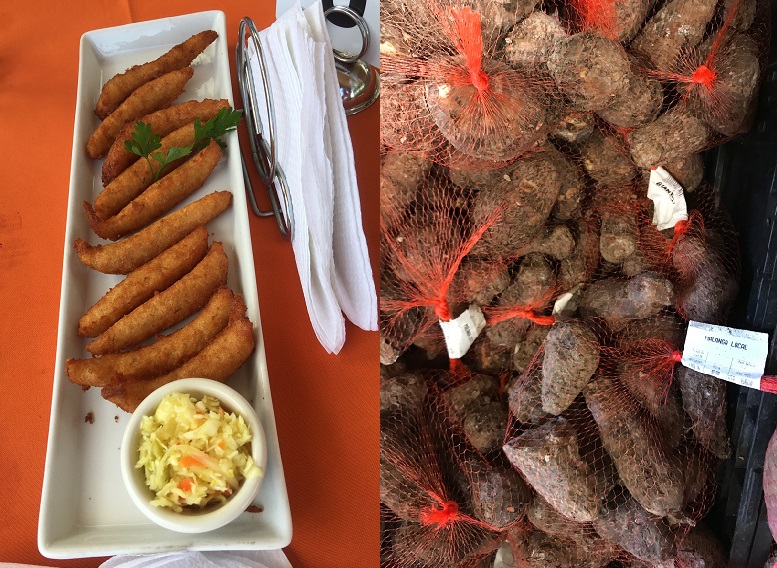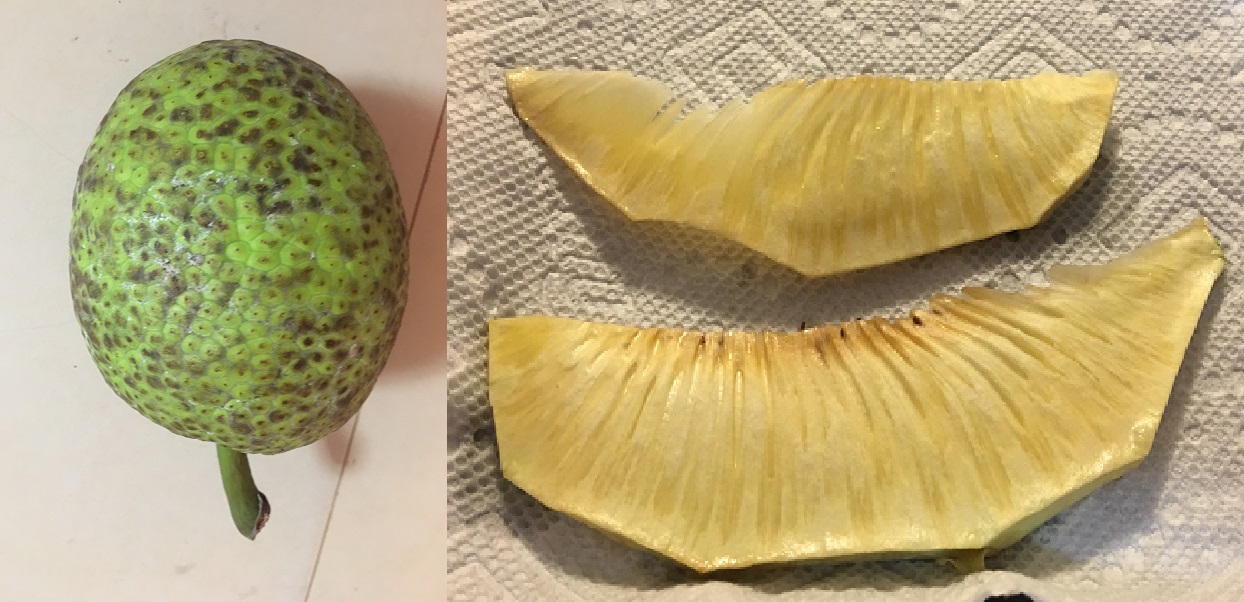News from Haiti Vol. 11 (Final): Culture of Haiti
Haiti’s Foodstuffs and Food Culture
Haiti is also known for its Haitian Creole cuisine. Haiti is a nation with a long history and blessed with natural resources, having been the site of cross-cultural communication through the ages. These factors have led to the creation of a unique food culture, continuing to develop with the addition of new innovations over time.
Looking at the food genre “Haitian Creole” through a historical lens, it has elements brought from the French, the indigenous people, and those brought from Africa, all mixed together while maintaining the genre’s traditions.
Adding to this base, Spanish, Central American, and even recently American influences can be seen, these being enjoyed from daily meals to gourmets/culinary arts in restaurants.
In addition to Creole cooking, there are other ingredients and foods that are characteristic to the food culture, which I will introduce below.
1 Part 1 Haitian Products and Ingredients Connecting the World
Directly and indirectly, historically and in little-known places we might be eating foods connected with Haiti. I will explain further below.

(Sugarcane)
Haiti is an important nation that has left a mark on the development history of a product we are indebted to daily: sugar. In the beginning, sugarcane from Asia made its way to Europe, and afterward made its way to Africa in search of cultivation lands. Then in 1493, on Christopher Columbus’ second voyage, he spread sugarcane seeds on the island of Hispaniola, which is considered to be the origin of sugarcane in the Caribbean region. Further down the road, sugarcane plantations became the underlying support of France’s economy, and also became the backbone all types of French and European sweets, many of which are still popular to this day. If there was no sugar from Haiti, there might not be any chocolate, cakes, tarts, etc. in the form that we know today.
Even now sugarcane fields spread over main production areas, and although the production lot has considerably decreased compared to the past, it is still a major crop. Sugarcane is still piled high on carts, cut and sold on the streets (it is a very fibrous food, but if chewed raw a sweet juice is released ensuring for a sweet treat), and in the fields the cane is taken to a facility where they squeeze the juice and through various stages simmer the juice until it becomes brown sugar (in Haiti it is called Rapadou, where it is wrapped in palm leaves and stored).

(Haiti’s brown sugar, Rapadou)

(Barbancourt’s 150th Anniversary Bottle)
In addition, at other smaller distilleries (rumors say over 500 locations!) rum was distilled using almost all of the same ingredients, which is called Clairin. It was enjoyed as a local rum and its popularity spread, but there have been cases of groups of people dying from alcohol poisoning after consuming bootleg Clairin which contained mixed impurities.
Grand Marnier
The orange liquor that is necessary to make (European) sweets and cocktails, Grand Marnier and Cointreau are major French brands; their main ingredient, the skins of bitter orange, is actually from Haiti (citrus bigaradia). The scent is so specific to Haiti that the brands only use Haitian bitter orange, and it is not an overstatement to say that the fruit is helping support both taste and tradition. This bitter citrus is grown in the northern region of Haiti; Grand Marnier uses 100% Haitian bitter orange whereas Cointreau uses 50/50 Haitian and Brazilian bitter oranges, making for different flavors. The abovementioned products are examples of foods that we use regularly without necessarily knowing they are products of Haiti.
Coffee and Cacao

(Sun-dried coffee beans and coffee being brewed. Bottom right: cacao)
I will introduce Creole cooking and daily meals in Haiti in the following paragraphs.
2 Part 2: Haiti Creole Cooking

(Soup Joumou (a hearty pumpkin soup))
When talking about Haiti’s traditions, culture, and history, one cannot forget to mention its pumpkin soup. The Soup Joumou (Creole: Soup Joumou; French: Soupe Giraumon) that is eaten on Independence Day (January 1st) is a pumpkin soup with lots of vegetables and meat inside.
There are many stories of its origins, but most simply it is a dish that the French settlers enjoyed, but which the slaves were denied the right to eat; however, with independence in 1804 the newly freed Haitians ate the soup as a symbol of the privileged French settlers, and is also said that Marie-Claire Heureuse Félicité, the wife of the first leader of Haiti, Jean-Jacques Dessalines, spread the custom of eating this soup, rich in nourishment, on Independence day. It is a mainly pumpkin-based soup, but one of its characteristics includes the addition of beef in it as well. The other vegetables included vary depending on households, with each family having their own preferences and flavors. A few standard vegetables are potatoes, carrots, and turnips, with celery added for flavor.
No matter the differences, Soup Joumou is a national dish that cannot be left out of Haitian communities. Articles about Soup Joumou are even published in the Miami Herald on January 1st, as it is home to one of the largest Haitian communities outside of Haiti.
Griot

(Griot (deep-fried pork))
Diri (ak) djon djon

(On the upper-left of Diri djon djon are common accoutrements; bottom-left is a fancier restaurant version; upper-right is djon djon spaghetti; bottom-right are dried djon djon mushrooms)

(Riz National)
Lambi

(Lambi Creole)
Acra

(Acra and Maranga potatoes)
Banane pesée

(The yellow accoutrements on the left-side are banana pesée (the dish itself is codfish croquettes))
Other Ingredients
I have introduced some of the typical dishes of Haitian-Creole cooking in this column. In addition to the abovementioned dishes, cabri (a type of goat also seen in Africa) and beef cooked in the same way as Griot is called Taso/Tasso, and is also a popular dish. Near the oceanside, lobster, octopus, and fish are also widely consumed.

(There are not many fish dishes, but they do exist (the yellow is banana pesée))

(Breadfruit (on the right are sliced, fried breadfruit))

(Mango and avocados can been found everywhere; on the upper-right are strawberries from Ranch Le Montcel; on the bottom are bananas and citrus found along the roadside)

(Selling coconuts street-side: getting coconut water)

(Prestige Beer and the factory)
(*This column reflects the personal views of the author and not the opinions of their employer)
Back numbers are here
WHAT'S NEW
- 2024.12.4 UPDATE
PROJECTS
"Barbados A Walk Through History Part 14"
- 2024.9.17 UPDATE
PROJECTS
"Barbados A Walk Through History Part 13"
- 2024.7.30 UPDATE
EVENTS
"408th Lecture Meeting Regarding Global Issues"
- 2024.7.23 UPDATE
PROJECTS
"Barbados A Walk Through History Part 12"
- 2024.7.9 UPDATE
ABOUT
"GREETINGS FROM THE PRESIDENT JULY 2024"
- 2024.7.4 UPDATE
EVENTS
"APIC Supports 2024 Japanese Speech Contest in Jamaica"
- 2024.6.27 UPDATE
EVENTS
"407th Lecture Meeting Regarding Global Issues"
- 2024.5.21 UPDATE
EVENTS
"406th Lecture Meeting Regarding Global Issues"
- 2024.5.14 UPDATE
EVENTS
"405th Lecture Meeting Regarding Global Issues"
- 2024.4.2 UPDATE
PROJECTS
"Water Tanks Donated to Island of Wonei, Chuuk, FSM"




